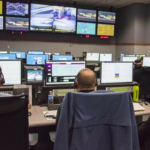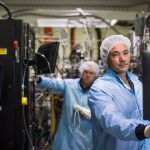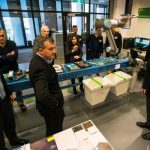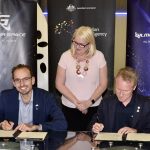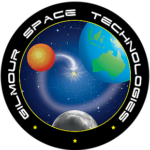Australia’s space industry reaches for the stars
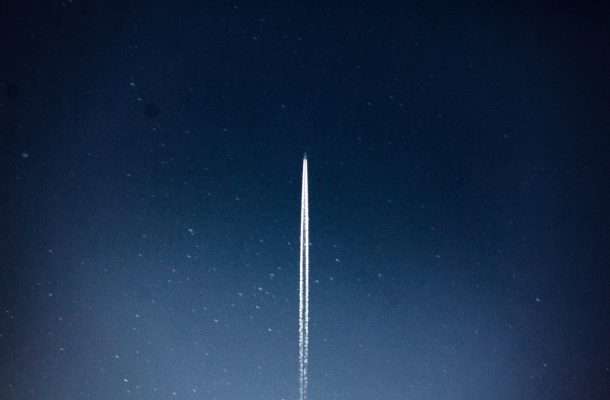
Space is a field of discovery that has a profound personal effect on people.
In 1969, I sat on the floor of my classroom watching, spellbound, as Neil Armstrong took his first steps on the Moon. I never dreamed that a few decades later, I’d be one of the first to see images from Pluto, as part of the critical role our CSIRO team at the Canberra Deep Space Communication Complex played in NASA’s New Horizons and Cassini missions.
How could a kid sitting in a classroom in Sydney, miles away from the rest of the world, believe Australia had such an important part to play in our exploration of space?
Today, it’s my hope that schoolchildren in Australia will grow up planning careers in space because they’ll see the growth in jobs and opportunities in the sector, and understand the unique role Australia plays in the global space network.
They’ll know Australia is positioned perfectly to look up into the centre of the galaxy – something you can’t do from many other parts of the world.
They’ll appreciate that Australia has a vast landmass with low light and radio interference to offer space tracking services to the rest of the world.
And they’ll be inspired to study STEM because they want to be part of the boom in Australia’s space industry, delivering economic returns and improving the lives of Australians. I’m confident we can instil this vision in them, because it’s what CSIRO has been doing for more than 75 years.
CSIRO in space
CSIRO’s work in space dates back to the 1940s, when we developed radar technology to protect Darwin during the war, and it’s grown exponentially since then, forming partnerships around the globe.
Our partnership with NASA stretches back more than 50 years, grounded in our world-class infrastructure and scientists at Canberra and Parkes, and fuelled into the future by our shared ambition to push the boundaries of exploration to benefit life back on earth.
CSIRO controls all NASA’s deep space assets worldwide for about a third of every day, using the ‘follow the sun’ protocol, as well as communicating with European and Indian spacecraft. It’s a rare day in our control centres when we don’t talk to partners on every part of the globe.
On a daily basis, many dedicated people across CSIRO work closely with more than a dozen international space organisations to deliver crucial insights through Earth observation.
They harness big data to solve challenges ranging from disaster prevention, bushfires, floods and spills, to biosecurity threats. We partner with the European Space Agency (ESA) to access their international satellite data, and with NASA to monitor places from the Great Barrier Reef, to the Great Australian Bight, to the Lake Eyre Basin and to the Adelaide Hills.
And just last week we were thrilled to see the successful launch of the NovaSAR Earth Observation satellite by Surrey Satellite Technology Ltd, or SSTL.
Last year CSIRO announced we’d purchased a ten per cent share of the satellite, giving Australian scientists first usage rights when it flies over Australia and Southeast Asia, strengthening our ability to understand our environment and prepare for our future, and for the first time ever, giving Australian scientists the ability to control an imaging satellite.
This announcement was followed by the recent launch of our CSIRO Centre for Earth Observation, which will provide a dedicated facility for satellite-derived data as we add critical human insight and knowledge to the firehose of big data coming our way.
Small and medium sized businesses in the new space industry
But you don’t have to be a space organisation to be part of CSIRO’s space team.
CSIRO works with industry to fill gaps in capability, and to provide technical and financial support to see these companies thrive and establish a vibrant industrial ecosystem.
Let me start at the Small and Medium Business size. One recent example is our partnership with EMC, a small business based in Perth, which is working to deliver the world’s first solar power solution suitable for a radioastronomy site, out at our Australian Square Kilometre Array Pathfinder (ASKAP) in Murchison, WA.
This same site will soon be the Australian home to the international SKA (Square Kilometre Array), which will become the world’s largest telescope. The project has been a brilliant result for EMC, who grew from a workforce of 10 to over 100 during the project and through joining Carnegie Clean Energy.
They’re now positioned to take on global radio astronomy energy tenders – and beyond. We’re also working with start-ups and spin-outs to turn their great benchtop ideas into commercial products.
CSIRO runs the nation’s only sci-tech Accelerator, ON. It’s an intensive, customer-focused program to take concepts from all Australian universities as well as CSIRO to market.
One of the teams to go through a recent round of the accelerator came out of CSIRO and was called ‘Optimus’.
They were developing a subscription package for universities to provide their undergrad students with hands-on introduction to radio astronomy observational techniques and data analysis, using pulsars as the context, and including supported access to telescope time at our 64 metre Parkes radio telescope.
Another team came out of the University of Southern Queensland called NEO Mining Solutions, aiming to identify which asteroids might have valuable mineral resources before we go to the effort of launching a rocket to land on them.
Their solution proposes harnessing the power of our global amateur telescope network to obtain detailed surface maps of bypassing asteroids, without leaving Earth. Another way we’re supporting the emerging Australian space industry is through our CSIRO Innovation Fund, managed by Main Sequence Ventures.
The Fund invests in new spin-outs, start-ups, and Small and Medium Enterprises engaged in the translation of research generated in the Australian publicly funded research sector, including the CSIRO and universities. Recent investments have included Fluorosat, a company spun out of the University of Sydney to provide farmers with real-time data about their crops with a satellite solution, and Myriota, an Internet of Things company providing solutions for companies with sensing requirements in really remote locations, away from urban internet connections.
We’ll have a third space investment through the Fund to announce in just a few days, so keep an eye out.
A new roadmap for Australian space industry
So with Australia on the cusp of its own space age, CSIRO stands ready to draw on our 75 years of experience in the space sector to help launch Australia into a new era.
CSIRO’s Space Roadmap draws on our networks within the Australian space industry, helping to inform the strategic direction now being developed by the new space agency, setting out viable opportunities that can help launch Australia’s space industry into a new era.
CSIRO’s national footprint, together with our broad sector engagement, long track record in space science, and technical capability all underpin our deep commitment to the development and expansion of Australia’s space industry.
The creation of a dedicated space agency signals a new approach for the sector, providing Australia with a co-ordinated body to strengthen industry relationships and promote Australia’s reputation as a dynamic and ambitious space-focused nation. In partnership with the agency, we look forward to transforming and growing a globally respected Australian space industry, opening up our markets, improving productivity, creating new jobs, and securing our STEM talent pipeline into the future.
This Space Roadmap introduces opportunities for growth and differentiation based on Australia’s natural advantages, and leveraging our established industries to repurpose for space – like new materials, mining to extract water, oxygen and inks to print spare parts, agriculture to grow food in inhospitable terrain, space object tracking, and space exploration and utilisation.
The next leap for humankind
CSIRO is a member of the International Space Exploration Coordination Group (ISECG) which brings together numerous international space agencies and research organisations to contribute to international collaborative missions.
ISECG has a coordinated vision to expand human exploration and presence in low Earth orbit, the Moon and on Mars over the next two decades. Exploration missions are expected to first be robotic, followed then by human missions, with the aim of characterizing new environments.
Human space exploration and utilisation will be enabled by the planned development of an international space gateway- a small facility in permanent orbit around the Moon facilitating regular access to the lunar surface and as a gateway to Mars and beyond.
So what does a multidisciplinary organisation like CSIRO bring to the table? How do we draw on our century of solving complex, multi-stakeholder challenges, moonshots if you will – including the original moonshot?
CSIRO has been improving life for all Australians for 100 years, and one of our earliest challenges was supporting farmers to grow crops that would survive in our dry climate. They call Mars the red planet – and the mission to Mars will need the kind of smarts CSIRO invented to grow food in our red landscape. Our food processing, plant breeding and synthetic biology skills will be increasingly relevant to extended spaceflight and establishing a sustained presence in hostile or challenging environments as are found on the Moon and Mars.
To establish robotic or human habitation centres in deep space, mission teams will need to mine raw materials to create the structures and parts they need – they’ll be 300 days away from Earth, so there’s no overnight courier. Again, CSIRO has been working with Australia’s mining industry for decades, and we recently learned to do something NASA’ll find very useful.
Instead of shipping out tonnes of mineral sands fresh out of the ground, we can now turn sand into Titanium ink to develop customised titanium parts, like this sternum, custom-designed saved a man’s life in Spain. With a 3D printer and some CSIRO know-how, the Mars mission will never run out of spare parts. Actually we beamed the digital image from the patient in Europe, to print the part here – but NASA will be able to beam it to and print it on the Moon or on Mars.
Our expertise in automation and robotics, including remote asset management is world-class, and an area that is critically important to ongoing space exploration. Our mining companies, METS industry and enabling research areas lead the world in resource utilisation, especially under extreme and remote environments Our health and medtech capabilities offer globally competitive services for human factors in extended spaceflight including telehealth, predictive healthcare and wearables.
Deep Collaboration between CSIRO, the Australian Space Agency, and partners in research, education, government, industry and investor communities will be critical to growing a diverse, robust and globally-competitive space industry.
CSIRO collaborates with every Australian research institution – Australia’s space advantage is driven by this network of brilliant minds, working collaboratively to deliver the best outcomes for our nation. We are here to help Australia secure our footprint in the space ecosystem.
Through CSIRO, through our new Australian Space Agency, and of course through the contributions each and every one of you make every day – our opportunity is as unlimited as space itself.
Dr Larry Marshall delivered this speech at the launch of CSIRO’s space industry roadmap at the 18th Australia Space Research Conference.
Dr Larry Marshall is a physicist and entrepreneur. In January 2015 he became the chief executive of the Commonwealth Scientific and Industrial Research Organisation (CSIRO), Australia’s national science agency.


